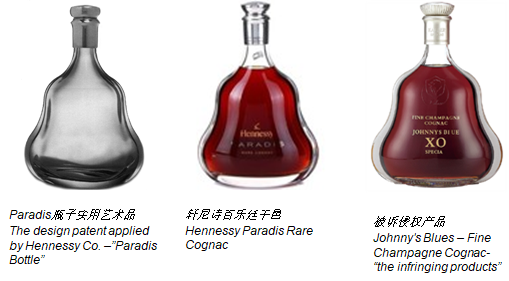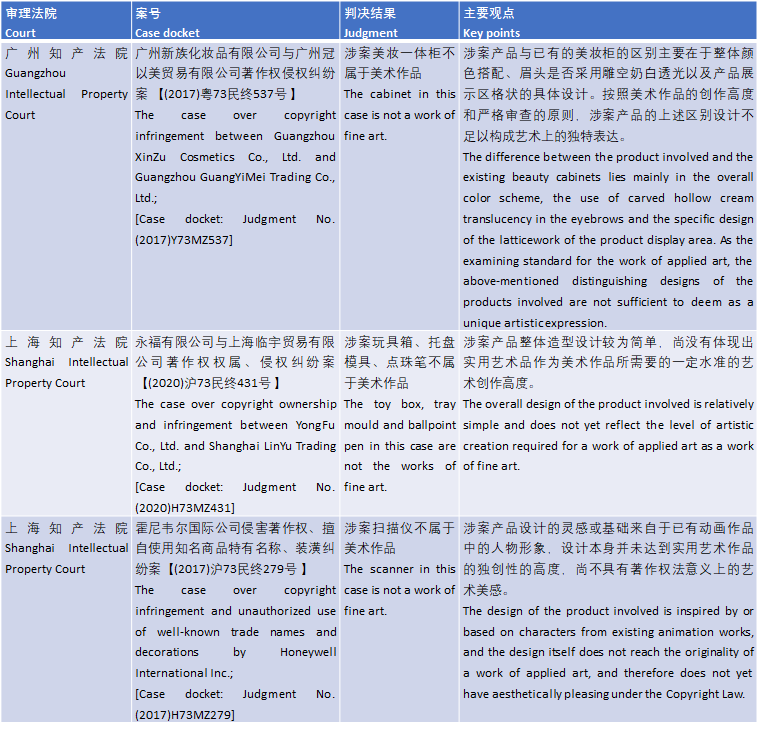Copyright Protection for Works of Applied Art
SOCIETE JAS HENNESSY & CO. v. Guangdong Kalaer Wine Co., Ltd.
A work of applied art, as the name suggests, considers its artistry and practical applicability. With the economic development and the continuous improvement of people’s aesthetic requirements, products are designed with a greater emphasis on originality, and designers have therefore created many unique designs. In practice, product design can be protected through a variety of patterns such as industrial design, three-dimensional trademark, unique trade dress for influential products, and work of applied art. We will discuss relevant legal provisions on work of applied art, the elements and evidence of ownership, with a view to the judicial protection of work of applied art in China, such as the case of SOCIETE JAS HENNESSY & CO. v. Guangdong Kalaer Wine Co., Ltd. on the infringement of copyright.
Case Docket: Judgment No. (2017)Y73MC3414 &Judgment No. (2019) YMZ1665
Case brief:
SOCIETE JAS HENNESSY & CO. (hereinafter referred to as “Hennessy Co.”) is the owner of the brand “HENNESSY”. Hennessy Co. commissioned a designer to design a bottle (hereinafter referred to as the “Paradis Bottle”) for its product Hennessy Paradis Rare Cognac/轩尼诗百乐廷, which was patented in France on April 23, 2001, and subsequently published in Taiwan on May 16, 2001, as the container for Hennessy Paradis Rare Cognac. Hennessy Co. then patented the design of the Paradis Bottle in a number of countries and regions, including China. And the products Hennessy Paradis Rare Cognac using the Paradis Bottle are widely sold in China and around the world and are renowned worldwide. The Paradis Bottle, with the smooth, simple lines and the thin and banded wings along the sides of the Paradis Bottle giving the whole bottle a light, aesthetically pleasing body, among which artistry and practical applicability can be separated from each other, can be determined as a work of applied art and protected by the Copyright Law as a work of fine arts.
However, in recent years, Hennessy Co. found that Guangdong Kalaer Wine Co., Ltd. and other companies jointly produced, promoted, and sold “Johnnys Blues – Fine Champagne Cognac” products in a bottle that was highly similar to the Hennessy Paradis Bottle. Therefore, the copyright infringement lawsuit was filed with the court by Hennessy Co., requesting that Guangdong Kalaer Wine Co., Ltd. and others be ordered to immediately stop producing and selling “Johnnys Blues – Fine Champagne Cognac” and compensate for damages, which was eventually heard by the Guangzhou Intellectual Property Court and the High People’s Court of Guangdong Province. The alleged infringing product was ultimately ruled to constitute an infringement of the work of applied art in the form of Paradis Bottle.
- Relevant legal provisions
Berne Convention for the Protection of Literary and Artistic Works (hereinafter referred to as “Berne Convention”) provides a clear list of the various categories of works, which is the origin of the concept of a work of applied art. Also, Berne Convention provides for the protection of work of applied art in each Member State for a period of not less than 25 years as of the completion of that work.
The expression “literary and artistic works” shall include every production in the literary, scientific, and artistic domain, whatever may be the mode or form of its expressions, such as books, pamphlets, and other writings; lectures, addresses, sermons, and other works of the same nature; dramatic or dramatic/musical works; choreographic works and entertainments in dumb show; musical compositions with or without words; cinematographic works to which are assimilated works expressed by a process analogous to cinematography; works of drawing, painting, architecture, sculpture, engraving, and lithography; photographic works to which are assimilated works expressed by a process analogous to photography; works of applied art; illustrations, maps, plans, sketches, and three-dimensional works relative to geography, topography, architecture or science.
In accordance with Article 7.4 of the Berne Convention, it shall be a matter for legislation in the countries of the Union to determine the term of protection of photographic works and that of works of applied art in so far as they are protected as artistic works; however, this term shall last at least until the end of a period of 25 years from the making of such a work.
However, there is no clear definition or legal provisions about a work of applied art in the latest revision Copyright Law of the People’s Republic of China, which has come into force on June 1, 2021, and the Regulation for the Implementation of the Copyright Law of the People’s Republic of China.
In 1992, the Rules for Implementing International Copyright Convention provides for a period of protection for the purpose of implementing the relevant provisions of the Berne Convention that “the period of protection for foreign works of applied art shall be 25 years as of the completion of that work, which shall not apply to works of applied art that used in industrial products”.
In cases judged in the past, such as the case concerning “Zoomer” [case docket: Judgment No. (2018) ZGFMS4387], the Court held that the period of protection for works of applied art under the implementing regulations should be 25 years as of the completion of that work, which is different from the period of protection granted to works of fine art under the Copyright Law, and therefore, the provisions on works of applied art are special provisions for works of fine art and should be applied in preference. The judgment may be the only provision regarding a work of applied art within laws and regulations.
2. Elements of a work of applied art and criteria for determining originality
1) Criteria for judging originality
A work of applied art to be protected by Copyright Law should firstly suffice the elements of a work. And in current judicial practice, the courts have higher requirements for the originality of a work of applied art, requiring creativity and being aesthetically pleasing. In Hennessy CO. v. Guangdong Kalaer Wine Co., Ltd. for the dispute over the infringement upon the Paradis Bottle, the court held that the overall contours of the Paradis Bottle were smooth, without any decorative patterns or carved designs on the outer surface of the bottle, and the overall simplicity and generosity of the Bottle; in particular, the thin ribbed edges along both sides of the Bottle made the whole Bottle lighter, and the combination of the curved contour design of the Bottle with strong artistic nature and originality mirrored the designer’s personalized expression, which was aesthetically pleasing, which could render the general public regard the Paradis Bottle as a work of applied art.

In addition, in the copyright infringement case concerning Range Rover Evoque [case docket: Judgment No. (2019) J73MZ2034], the Court found that, in terms of the independent creation, the overall exterior design of “Range Rover Evoque” is an independent creation in the overall arrangement of the elements and components in combination with existing elements; and in terms of originality, the exterior design of “Range Rover Evoque” in this case did not meet the minimum requirement of originality for a work of fine art as the general public viewed it more as an industrial product than a work of applied art. The court concretized the standard of originality as to whether the relevant public regarded it as a work of applied art.

Upon the study of many relevant cases, we have found that the courts everywhere and at all levels have adopted a high standard when examining the creation of a work of applied art.

The reason for strict examining standards on the originality of a work of applied art is that a reasonable judgment on the artistic creation of a work of applied art and placing it under the protection of the Copyright Law will not have an impact on the design patent system. And also the determination of a work of applied art can better regulate the market and encourage innovation. With regard to the determination of originality, the right holder, in addition to elaborating on the main points of the design and inventiveness, also collected a large amount of evidence for illustration when adducing evidence, mainly through the following aspects: firstly, the acquisition and registration of other rights, including patent certificates, patent rights evaluation reports, graphic trademarks, application for registration of three-dimensional trademark; secondly, promotion and publicity, including design awards, media reports, and recognition and evaluation by the relevant public, comparison with existing designs, etc.
2) The Physical or conceptual separation of Artistry and practical applicability
As the practical applicability does not fall within the scope of the Copyright Law, the only thing that is protected is its artistry for a work of applied art. It is mainly divided into physical separation, where the two can be physically detached from each other and exist separately, and conceptual separation, where the alterations and designs made to the artistic part of the work of applied art do not affect the realization of the practical function. The High People’s Court of Guangdong Province and Guangzhou Intellectual Property Court also examined this in the Paradis Bottle case, finding that alterations to the existing design of the Paradis Bottlewould did not affect the Bottle’s function of storing spirits and that the elements of practical applicability and artistry being conceptually separable from each other were met.
3) Evidence of copyright ownership
Proof of copyright ownership is one of the difficulties in copyright infringement dispute cases. In the Interpretation of the Supreme People’s Court Concerning the Application of Laws in the Trial of Civil Disputes over Copyright, it is stipulated that the manuscripts, original scripts, lawful publications, copyright registration certificates, attestations issued by authentication institutions, contracts for acquiring rights, etc. as submitted by the parties concerned may be adopted as evidence; and the natural persons, legal persons or other organizations which appear on work or production as authors shall be deemed as the holder of the copyright or copyright-related rights and interests unless there is evidence that proves the opposite. In the dispute case between Harbin Zheng Lin Software Company and Hua Gai Company over copyright ownership infringement, the Court adopted the later supplemented statement on copyright ownership. Inspired by this, in the case of the copyright infringement of the Paradis Bottle, where the available evidence could prove the author, we submitted an additional declaration of copyright ownership signed by the designer, which was adopted by the High People’s Court of Guangdong Province, which held that Hennessy Co. was found to be the owner of the Paradis Bottle and enjoyed the copyright of the Paradis Bottle and that this form of evidence could also be used as a reference for similar cases.
Authors:


